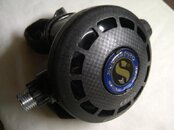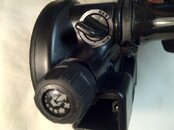windapp
Contributor
I just bought a new-to-me G250. It looks brand new in the pictures, but I know it has been shelved for 8 years. I think it was made around the turn of the century. It looks like the G250 HP except that it is a G250. I have the schematic for the 109, and the G250V. I am pretty sure that the G250 is very similar to the G250V in construction. My plan is to put it in service is this:
1. Do the standard tests. Check for water-tightness, and check that it doesn't freeflow (or hiss when not being breathed), and check the cracking pressure by submerging in the sink.
2. Take it apart, clean the parts with dish soap and water, rinse thouroughly, and put it back together, lubricating the o-rings and threads lightly with silicone greese after I have inspected the o-rings and the low pressure seat for wear and cracking.
3. Repeat the standard tests.
I was wondering if I could get some tips.
1. Is dish soap good for cleaning o-rings and regulator parts?
2. Are there parts I need to be careful about damaging (other than shredding the seat with the orifice) when i dis-assemble and re-assemble the regulator? I don't intend on removing the exhaust valve as I know these almost always have to be replaced if they are removed. Does the same thing go for the venturi knob? I also noticed that in the G250V, the retaining pin for the cover is a yearly replacement part. Will I have to replace it if I remove it or can I put it back or is there even a retaining pin in the G250?
3. How much engraving on the seat would you consider to be acceptable for another years worth of use?
1. Do the standard tests. Check for water-tightness, and check that it doesn't freeflow (or hiss when not being breathed), and check the cracking pressure by submerging in the sink.
2. Take it apart, clean the parts with dish soap and water, rinse thouroughly, and put it back together, lubricating the o-rings and threads lightly with silicone greese after I have inspected the o-rings and the low pressure seat for wear and cracking.
3. Repeat the standard tests.
I was wondering if I could get some tips.
1. Is dish soap good for cleaning o-rings and regulator parts?
2. Are there parts I need to be careful about damaging (other than shredding the seat with the orifice) when i dis-assemble and re-assemble the regulator? I don't intend on removing the exhaust valve as I know these almost always have to be replaced if they are removed. Does the same thing go for the venturi knob? I also noticed that in the G250V, the retaining pin for the cover is a yearly replacement part. Will I have to replace it if I remove it or can I put it back or is there even a retaining pin in the G250?
3. How much engraving on the seat would you consider to be acceptable for another years worth of use?





